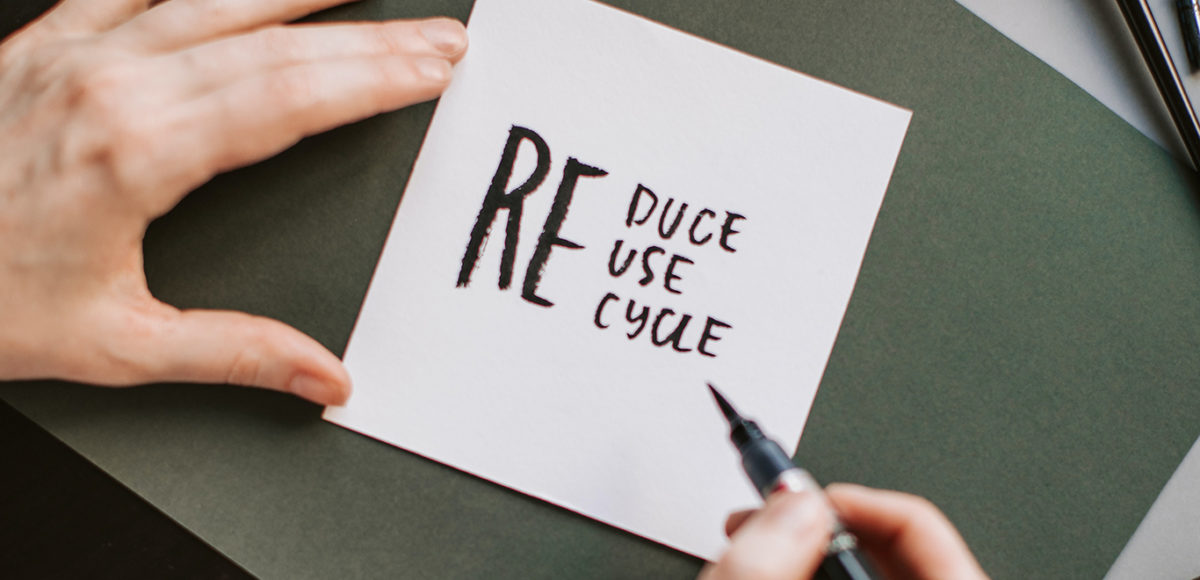A carbon footprint is the total amount of greenhouse gas (GHG) emissions that a person, product, entity, or event releases into the atmosphere. Greenhouse gasses are compounds like carbon dioxide, methane, and nitrous oxide that produce the “greenhouse effect” that contributes to climate change and global warming. For ease of comparison, a carbon footprint is expressed in units of carbon dioxide equivalents, or CO2e.
To figure out a product’s carbon footprint, you add up the emissions it creates through every stage of its lifetime. A cheeseburger’s carbon footprint, for example, includes the energy needed to grow the feed for the cattle to make the patty and cheese, grow the wheat for the bun, slaughter the cow, refrigerate the ingredients, transport them to the restaurant, cook the burger, package and sell it.
Your personal carbon footprint is the total greenhouse gas emissions your daily choices create, both directly and indirectly. For example, if you choose to recycle plastic, your carbon footprint is lower than if you throw it in the trash. When you choose to buy less plastic in the first place, your carbon footprint is even lower. Interested in knowing what your carbon footprint is? Use a carbon footprint calculator provided by the Environmental Protection Agency (EPA) or The Nature Conservancy.
Your carbon footprint is affected by just about everything you do, including what you choose to eat, your travel habits, what you throw away, your shopping habits, and your home energy use. Take a look at five shocking stats about greenhouse gas emissions, and learn what you can do to minimize your carbon footprint.
Going Vegetarian for One Day Is Equivalent to Sharing a Ride to Work
The University of Michigan’s Center for Sustainable Systems (CSS) estimates that going meatless for just one day each week of the year could save the same amount of energy expended by driving 1,160 miles.
When you break that down, each vegetarian meal saves as many emissions as a 22-mile roundtrip commute produces. That’s because vegetables and grains have a lower carbon footprint than meat and dairy products. Animals like cattle produce a lot of methane, and the production process of meats uses more energy than that of vegetables. Eating a vegetarian diet lowers your carbon footprint significantly, and substituting some of your beef meals for poultry can help too.
Opting Out of Junk Mail Can Help Save 80 to 100 Million Trees a Year
Reducing the waste you produce also lowers your carbon footprint. We all get junk mail, but did you know you can stop most of it from reaching your mailbox? Organizations such as the Direct Marketing Association and OptOutPrescreen can help you figure out how.
The Sierra Club reports that the average American gets 41 pounds of junk mail every year. Most of that ends up in landfills unread, according to the EPA. The amount of paper used to create America’s junk mail requires cutting 80 to 100 million trees a year. These trees could absorb 1.7 million tons of CO2 a year if left standing, Sierra Club explains. Getting rid of junk mail is one effective way to reduce waste.
By Driving the Speed Limit, You Use Between 7-14 Percent Less Fuel
Transportation contributes to 28.9 percent of total greenhouse gas emissions in the US, says the EPA. That’s the largest share among the economic sectors, including electrical, industrial, agricultural, and commercial and residential. Transportation includes trucks, airplanes, boats, trains, busses, and motorcycles, but passenger cars create 41% of the total transportation greenhouse gases, according to CSS.
By practicing energy-efficient car care and driving habits such as driving the speed limit, keeping your tires properly inflated, and using cruise control on longer trips, you can lower your carbon footprint. Or, ditch your car now and then and opt to walk, carpool, bike, or take the bus.
Using Your Dishwasher Can Save 9 Times More Energy and Water Than Hand Washing
It used to be that using your dishwasher meant wasting large amounts of water and driving your electricity bill up. But today’s energy-efficient dishwashers actually use less water and energy than washing dishes by hand.
NRDC reports that Americans use up to 27 gallons of water per load of dishes washed by hand. But the Department of Energy sets standards that limit dishwashers to no more than five gallons of water per cycle, and a compact dishwasher can use no more than 3.5 gallons, reports NPR. Plus, today’s Energy Star-rated dishwashers use less electricity. Lower your carbon footprint at home by using your dishwasher, buying other Energy Star-rated appliances, and adopting energy-efficient habits such as switching off lights when you leave the room, turning your water heater down to 120 degrees Fahrenheit and switching out your incandescent bulbs for LEDs.
Over 12.2 Million Tons of Furniture and Carpeting Went to Landfills in One Year
America is accustomed to being a disposable society, and that even applies to expensive durable goods such as furniture and carpeting. In 2017, the EPA calculated that Americans threw away over 15 million tons of furniture and carpeting. Of that, municipal solid waste facilities were able to combust 2.9 million tons for energy recovery. But the remaining 12.2 million tons ended up in landfills.
A better alternative that has a much lower carbon footprint is renting and reusing durable furnishings. Furniture rental allows for reuse, which positively impacts the environment. Renting furniture from CORT, for example, saves 368,862 tons of CO2 from being released into the atmosphere each year. That’s the equivalent of the total energy use for 35,335 homes in one year.
Additional ways you can reduce your carbon footprint while shopping is to buy less, use reusable bags at the store, shop at second-hand stores, avoid items with excess packaging, and choose environmentally conscious brands.
At CORT Furniture Rental, we’re on a mission to positively impact the communities we serve, while reducing our impact on the environment. Renting our products for your home, office or event allows you to use high-quality and commercial grade furnishings at a fraction of the cost of buying and without making a long-term commitment. And our business model that includes using, fixing, reusing, and buying keeps more durable goods out of landfills and reduces the world’s carbon footprint. Turn to CORT to help reduce your carbon footprint. Own your life. Not your furniture.
Photo by Vlada Karpovich from Pexels






